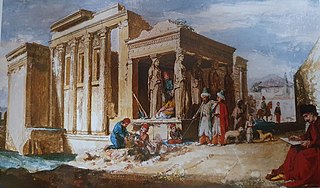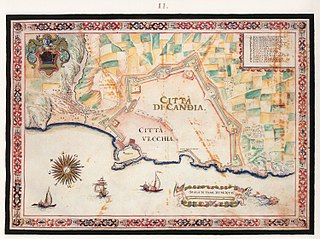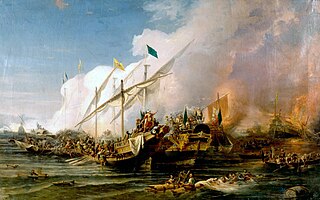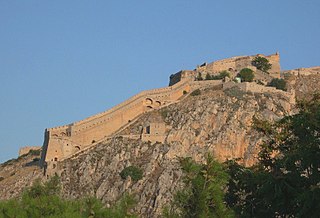
The Orlov revolt was a Greek uprising in the Peloponnese and later also in Crete that broke out in February 1770, following the arrival of Russian Admiral Alexey Orlov, commander of the Imperial Russian Navy during the Russo-Turkish War (1768–1774), at the Mani Peninsula. The revolt, a major precursor to the Greek War of Independence, was part of Catherine the Great's so-called "Greek Plan" and was eventually suppressed by the Ottomans.

Most of the areas that are in modern Greece's borders were at some point part of the Ottoman Empire. The period of Ottoman rule in Greece, lasting from the mid-15th century to the successful Greek War of Independence that broke out in 1821 and the First Hellenic Republic was proclaimed in 1822, is known in Greek as Tourkokratia. Some regions, however, like the Ionian islands, various temporary Venetian possessions of the Stato da Mar and Mani Peninsula in Peloponnese did not become part of the Ottoman administration, but the last was under Ottoman suzerainty.

The Great Turkish War, also called the Wars of the Holy League, was a series of conflicts between the Ottoman Empire and the Holy League consisting of the Holy Roman Empire, Poland-Lithuania, Venice, Russia, and the Kingdom of Hungary. Intensive fighting began in 1683 and ended with the signing of the Treaty of Karlowitz in 1699. The war was a defeat for the Ottoman Empire, which for the first time lost substantial territory, in Hungary and the Polish–Lithuanian Commonwealth, as well as in part of the western Balkans. The war was significant also for being the first instance of Russia joining an alliance with Western Europe.

Antonio I Acciaioli, also known as Anthony I Acciaioli or Antonio I Acciajuoli, was Duke of Athens from 1403.

The Morean War, also known as the Sixth Ottoman–Venetian War, was fought between 1684–1699 as part of the wider conflict known as the "Great Turkish War", between the Republic of Venice and the Ottoman Empire. Military operations ranged from Dalmatia to the Aegean Sea, but the war's major campaign was the Venetian conquest of the Morea (Peloponnese) peninsula in southern Greece. On the Venetian side, the war was fought to avenge the loss of Crete in the Cretan War (1645–1669). It happened while the Ottomans were entangled in their northern struggle against the Habsburgs – beginning with the failed Ottoman attempt to conquer Vienna and ending with the Habsburgs gaining Buda and the whole of Hungary, leaving the Ottoman Empire unable to concentrate its forces against the Venetians. As such, the Morean War was the only Ottoman–Venetian conflict from which Venice emerged victorious, gaining significant territory. Venice's expansionist revival would be short-lived, as its gains would be reversed by the Ottomans in 1718.
The Ottoman–Venetian wars were a series of conflicts between the Ottoman Empire and the Republic of Venice that started in 1396 and lasted until 1718. It included:

The Seventh Ottoman–Venetian War was fought between the Republic of Venice and the Ottoman Empire between 1714 and 1718. It was the last conflict between the two powers, and ended with an Ottoman victory and the loss of Venice's major possession in the Greek peninsula, the Peloponnese (Morea). Venice was saved from a greater defeat by the intervention of Austria in 1716. The Austrian victories led to the signing of the Treaty of Passarowitz in 1718, which ended the war.

The Cretan War, also known as the War of Candia or the Fifth Ottoman–Venetian War, was a conflict between the Republic of Venice and her allies against the Ottoman Empire and the Barbary States, because it was largely fought over the island of Crete, Venice's largest and richest overseas possession. The war lasted from 1645 to 1669 and was fought in Crete, especially in the city of Candia, and in numerous naval engagements and raids around the Aegean Sea, with Dalmatia providing a secondary theater of operations.

The Frankokratia, also known as Latinokratia and, for the Venetian domains, Venetokratia or Enetokratia, was the period in Greek history after the Fourth Crusade (1204), when a number of primarily French and Italian states were established by the Partitio terrarum imperii Romaniae on the territory of the dissolved Byzantine Empire.

The First Ottoman–Venetian War was fought between the Republic of Venice with its allies and the Ottoman Empire from 1463 to 1479. Fought shortly after the capture of Constantinople and the remnants of the Byzantine Empire by the Ottomans, it resulted in the loss of several Venetian holdings in Albania and Greece, most importantly the island of Negroponte (Euboea), which had been a Venetian protectorate for centuries. The war also saw the rapid expansion of the Ottoman navy, which became able to challenge the Venetians and the Knights Hospitaller for supremacy in the Aegean Sea. In the closing years of the war, however, the Republic managed to recoup its losses by the de facto acquisition of the Crusader Kingdom of Cyprus.

The Third Ottoman Venetian War (1537–1540) was one of the Ottoman–Venetian wars which took place during the 16th century. The war arose out of the Franco-Ottoman alliance between Francis I of France and Süleyman I of the Ottoman Empire against the Holy Roman Emperor Charles V. The initial plan between the two had been to jointly invade Italy, Francis through Lombardy in the North and Süleyman through Apulia to the South. However, the proposed invasion failed to take place.
Turahanoğlu Ömer Bey was an Ottoman general and governor. The son of the famed Turahan Bey, he was active chiefly in southern Greece: he fought in the Morea against both the Byzantines in the 1440s and 1450s and against the Venetians in the 1460s, while in 1456, he conquered the Latin Duchy of Athens. He also fought in Albania, north-east Italy, Wallachia and Anatolia.

The siege of Corfu took place on 8 July – 21 August 1716, when the Ottoman Empire besieged the city of Corfu, on the namesake island, then held by the Republic of Venice. The siege was part of the Seventh Ottoman–Venetian War, and, coming in the aftermath of the lightning conquest of the Morea by the Ottoman forces in the previous year, was a major success for Venice, representing its last major military success and allowing it to preserve its rule over the Ionian Islands.

The Kingdom of the Morea or Realm of the Morea was the official name the Republic of Venice gave to the Peloponnese peninsula in southern Greece when it was conquered from the Ottoman Empire during the Morean War in 1684–99. The Venetians tried, with considerable success, to repopulate the country and reinvigorate its agriculture and economy, but were unable to gain the allegiance of the bulk of the population, nor to secure their new possession militarily. As a result, it was lost again to the Ottomans in a brief campaign in June–September 1715.

The siege of Santa Maura took place on 21 July – 6 August 1684 between the forces of the Republic of Venice and the Ottoman Empire, and was the opening battle of the Sixth Ottoman–Venetian War.

The siege of the Acropolis took place on 23–29 September 1687, as the Venetian army under Otto Wilhelm Königsmarck laid siege to the Acropolis of Athens, held by the Ottoman garrison of the city. The siege resulted in the destruction of a large part of the Parthenon, which the Ottomans used as a gunpowder store.
The Ottoman reconquest of the Morea took place in June–September 1715, during the Seventh Ottoman–Venetian War. The Ottoman army, under Grand Vizier Silahdar Damat Ali Pasha, aided by the fleet under Kapudan Pasha Canım Hoca Mehmed Pasha, conquered the Morea peninsula in southern Greece, which had been captured by the Republic of Venice in the 1680s, during the Sixth Ottoman–Venetian War. The Ottoman reconquest inaugurated the second period of Ottoman rule in the Morea, which ended with the outbreak of the Greek War of Independence in 1821.

The siege of Nauplia took place on 12–20 July 1715, when the Ottoman Empire captured the city of Nauplia, the capital of the Republic of Venice's "Kingdom of the Morea" in southern Greece. Although Nauplia was strongly fortified and had been further strengthened with the construction of Palamidi fortress by the Venetians, the Ottomans managed to overcome them, largely through the treasonous assistance of the French colonel La Salle. The Ottomans exploded a mine and took Palamidi by storm on 20 July. The Venetian defenders retreated in panic, leading to the rapid fall of Acronauplia and the rest of the city. The garrison and populace were massacred or carried off as prisoners. The fall of Nauplia signalled the effective end of Venetian resistance to the Ottoman reconquest of the Morea, which was completed by 7 September.

The Castle of Santa Maura is a fortress on the northeastern tip of the Greek island of Lefkada. The castle began as a small fortification in c. 1300 to control access to the island, before it was expanded to become a walled town and the island's capital by the early 15th century. The Ottoman Empire took possession in 1479, and a century later rebuilt and enlarged it, giving it largely its present shape. A sizeable town grew outside the castle walls by the 1670s.

Girolamo Corner or Cornaro was a Venetian nobleman and statesman. He served in high military posts during the Morean War against the Ottoman Empire, leading the Venetian conquest of Castelnuovo and Knin in Dalmatia, the capture of Monemvasia in Greece and of Valona and Kanina in Albania.















